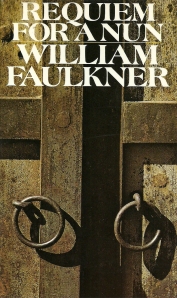Requiem for a Nun ~ A Capsule Book Review By Allen Kopp
William Faulkner, the master of twentieth century Southern American gothic writing, wrote Requiem for a Nun as a sort of sequel to his novel Sanctuary, meaning that it’s a brief glimpse into the life of fallen woman Temple Drake eight years after the close of Sanctuary. Requiem for a Nun was written around 1951, when Faulkner was 54 years old, about twenty years after Sanctuary.
Requiem for a Nun is an odd little book, not a traditional novel. The story is told in dramatic form, meaning that reading it is like reading a play. That’s not all, though. The “acts” of the novel are interspersed with some of Faulkner’s dense prose; dense in the sense that sentences are frequently half-a-page long or longer, and you won’t know what he’s saying unless you’re reading carefully and go back and break down the sentences into their various parts. Faulkner is the master of interjectional writing. Great writer though he was, it’s as if his mind was so twisted with interweaving thoughts that he couldn’t finish one thought before he started in on another. I suppose this is part of his “innovation,” although not easy on the reader.
The “narrative” portions of the book that are interspersed with the “dramatic” portions are about the fictional history of the fictional town of Jefferson, Mississippi, in fictional Yoknapatawpha County; specifically the jail, the courthouse, and how the town was begun. These fictional historical details actually have nothing to do with the “story” told in dramatic form.
Readers familiar with the character Temple Drake from Faulkner’s earlier novel Sanctuary know that she ended badly. She was witness to a murder and lied on the witness stand to defend the real murderer, a deformed thug named Popeye, who took her to Memphis and set her up in a whorehouse to keep her from going to the police and telling them what she knew. Requiem for a Nun picks up her story eight years later. She is free of Popeye (he was hanged for another crime that he apparently was innocent of) and is married to her drunken male companion, Gowan Stevens, from Sanctuary. They have two children, an infant daughter and a slightly older son.
Temple has taken a black woman named Nancy Mannigoe, former drug addict and prostitute, into her house as a sort of governess for her two small children. Temple believes she is saving Nancy from her terrible life and giving her a chance to have a better one. When the action of Requiem for a Nun begins, Nancy has murdered Temple and Gowan’s baby daughter in her crib and is going to be executed in a few days for her crime. Temple decides within two days of Nancy’s execution that she herself is responsible for the murder of her own baby, beginning with her actions eight years earlier, and attempts to save Nancy’s life. There is one very long scene where she and her husband’s lawyer uncle go and see the governor of the state in the state capital in the middle of the night to plead for Nancy’s life, even though Temple knows there is no use.
Since there is no nun in Requiem for a Nun, I’m not sure what the title means, although I’m figuring it refers to Nancy Mannigoe. She goes to her death serenely because she believes she deserves to die and because she is a “believer.” Nancy’s serenity is something that Temple Drake cannot touch, understand or share. She is a tormented woman and we get the distinct impression that she will never be anything but that.
Copyright © 2013 by Allen Kopp


Third-wave feminists must go nuts with scorn concerning the assumptions of ‘proper womanly behaviour’ evident in this work. Certainly, Guilt is a major preoccupation here. Irrational guilt, I think.
I was blindsided by the Religious content of the final section. That was quite absent from SANCTUARY.
First, I appreciate the summary review. One thing more: The word nun was Elizabethan slang for a prostitute, perhaps because it allowed for adults talk about such in the presence of children without them having a clue. (Of course nobody is born knowing this and it’s a gap in our education.)